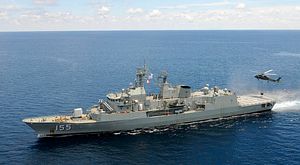In February, Australia announced that it plans to dramatically increase the size of its navy over the next decade. If successful, the Royal Australian Navy (RAN) would more than double the number of its major surface combatant ships, from 11 to 26 vessels. This would be the largest the RAN has been since the end of World War II.
The move reflects Australia’s recognition of the evolving security challenges in the Indo-Pacific region, particularly the increasing assertiveness of China. If the Australian government follows through with sufficient funding, this decision will also show that Australia’s defense spending flows from its national defense strategy, and that it is avoiding the unfocused defense spending that has plagued some other U.S. partners and allies (and for that matter, the United States itself).
Taiwan, for example, has struggled to keep its defense spending focused on its strategic goals. Despite announcing a new Overall Defense Concept based on asymmetric warfare that has been widely praised by defense experts, Taiwan’s armed forces have over-allocated resources toward expensive and vulnerable prestige systems, leaving essential asymmetric platforms well suited to resisting an amphibious invasion underfunded. In contrast, Australia’s decision to focus its spending on surface combatants that can protect its northern coast is a wise spending choice and deserves praise.
Australia’s defense overhaul comes at a pivotal moment, as geopolitical shifts and technological advancements reshape the nature of warfare. The rising threat of cyberwarfare and more advanced missile systems are quickly erasing the relative geographical isolation Australia has enjoyed from Asia. The 2023 Australian Defense Strategic Review recommended a “strategy of denial,” a defensive approach to stop adversaries from coercing and threatening with the use of force within a given area. The review recommended the development of nuclear powered submarine programs, quick acquisition of long-range strike missiles, improvements for the F-35A Joint Strike Fighter and F/A-18F Super Hornet aircraft to operate long-range anti-ship missile systems, and expansion of the shipyard workforce.
Now, the Australian government aims to double its fleet of combat-ready ships by investing an additional US$7.3 billion over the next decade. Included in the plan is the acquisition of six new Hunter-class frigates. These frigates will be among the most advanced anti-submarine warships in the world, and will incorporate advanced technology like the U.S. Navy’s Aegis combat management system. The plan also includes the acquisition of six optionally manned vessels – warships that do not need to be crewed.
This comes on the heels of the U.S., United Kingdom, and Australia announcing the AUKUS partnership in 2021, an agreement with the goal of developing an Australian nuclear-powered submarine program. Under the agreement, the U.S. will be selling three nuclear-powered Virginia-class submarines to the RAN while also sharing technical expertise to help Australia build nuclear submarines on its own in the future.
To ensure the success of its ambitious new plans, Australia will need to address past shortcomings in defense procurement and ensure that investments translate effectively into operational capabilities. Over the years, Australia’s defense projects (not unlike many of the United States’) have faced numerous hurdles, ranging from cost overruns to delays, often overshadowed by political considerations and local job creation agendas. Now, former senior security officials are calling for a streamlined procurement process to overcome these problems.
Ideally, some of the funding would come with the next defense budget release in April, but it seems that the new spending will not begin until 2027. Australia’s new plans will only work if adequately funded, and Australian policymakers might consider moving this timeline forward if they want to avoid the spending decision mistakes others have made.
Australia’s strategic recalibration reflects the country’s proactive approach to safeguarding its national interests in an era marked by unprecedented challenges and uncertainties. Australia has fought alongside the U.S. in every war since World War I and is one of Washington’s closest allies. This new initiative shows that Canberra is taking the threat from China seriously and continues to be committed to the alliance with the United States.
The U.S. should welcome this effort and ensure that its own defense spending priorities are strategically focused by emphasizing the procurement of warships, planes, and munitions relevant to the Indo-Pacific in its spending plans.
































